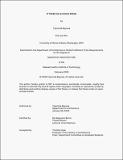If These Hills Could Speak
Author(s)
Bayowa, Tejumola
DownloadThesis PDF (36.68Mb)
Advisor
Barrio, Roi Salgueiro
Terms of use
Metadata
Show full item recordAbstract
If these hills could speak, what would they reveal, and how would they express it? This central question guides this thesis, which examines three hills in the heart of Ibadan, Southwest Nigeria— each occupied by the ruins of colonial monuments. Before the construction of these structures, the hills served as sanctuaries, providing water, food, and safety. However, under British colonial rule, architecture was utilized to disrupt this harmonious relationship. Over the course of 50 years, three monuments were erected that mark Britain’s colonial imprint on the city: a neoclassical courthouse (1925), built to assert control over the central market; a 60-foot tower (1936), which displaced the surrounding forests; and a theater (1977), built during a time of national struggle for unity and identity. Today, at the foot of these hills, a community has forged a way of life within a broken system. By repurposing and subverting structures in ways their creators never intended, this community embodies a praxis and poiesis of adaptive creativity within the built environment. This process represents a transformative act of pidginization—a collective tactic for repair, resistance, and reappropriation in response to an ongoing, imposed socio-political order. For these hills to speak again, the ruins must be transformed. This thesis begins that process by applying acts of pidginization learned from below to the three ruins. It proposes their conversion through deconstruction and de-monumentalization, with the aim of fostering economic development, ecological restoration, and cultural production in the city.
Date issued
2025-02Department
Massachusetts Institute of Technology. Department of ArchitecturePublisher
Massachusetts Institute of Technology